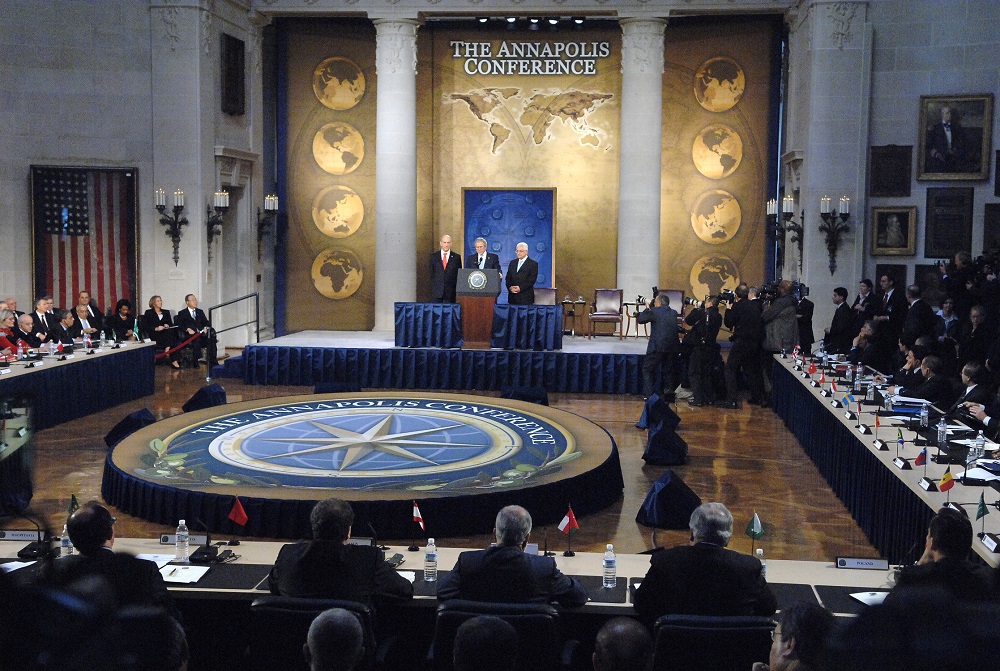The Search for Security
With no prospect of renewing political negotiations with the Palestinians or reaching an agreement with them, and barring any possibility of subduing the Palestinians militarily or motivating them to suspend the use of violence, Israelis are searching for a solution, short of all-out war, to keep the devil out. Unless one of the other military or diplomatic approaches (like the Saudi Initiative) suddenly looks serious, political separation is the next item on the Israeli agenda.
In a nation both blessed and cursed with an excess of history, and driven by the devastation and despair wrought by suicide terrorists in the heart of her cities, Israelis are beginning to wonder whether they will ever find their place in a region where government newspapers promote Holocaust denial and suicide bombers are revered as holy men.
The Palestinians have turned terror and the indiscriminate murder of Jews on both sides of the Green line into a war of attrition – a guerilla war – a quagmire that is devouring Israel’s men, women, children and resources, sapping her morale and dividing her people.
–break–
Rising out of the Oslo peace process was the dream of a benign Middle East that promised economic and cultural integration and prosperity between Israelis and Palestinians. Rising out of the sashes of Oslo is a nation that is moving from dread to fatalism with a growing belief that the only way to ensure her survival is to separate from those who seek her destruction.
In so doing, Israelis face a “Hobson’s Choice†in trying to choose from the lesser of several evils.
Unlike the hopes that began a decade ago, the Israeli mindset has reduced itself to two fundamental realities. The first is that there is no prospect of renewing the political negotiations with the Palestinians and reaching an agreement with them barring some dramatic developments in the unforeseeable future. The second assumption is that there is no possibility of subduing the Palestinians militarily or motivating them to suspend the use of violence.
The conclusion currently rising to the surface of this tragic debate is the need to create a buffer or a separation between Israel and West Bank in order to prevent suicide attackers from infiltrating into Israeli territory. In an environment where continuing Palestinian violence has proven resistant to both military attempts at suppression and political attempts to achieve a cease-fire and renew the political process, the nature of the “separation†itself has become a political issue in Israel, each based on a different political objective.
The first alternative favors a security (not a political) “disengagement†to the pre-1967 borders based on the assessment that the most severe problems posed by Palestinian violence are terrorist attacks and suicide bombings within Israel proper. This Plan would not change the existing geographical division of areas controlled by the Israelis and the Palestinians. It would set up a series of physical barriers, trenches and Israeli force concentrations along the pre-1967 borders in order to make it more difficult for would-be attackers to enter Israel proper. Settlements would continue to be protected by the same means currently used. The idea is to deploy electronic security devices, barriers, battalions of soldiers and police, trenches, minefields, walls, dogs and fences, and require entry permits limiting crossing only to formal transit checkpoints.
This approach sidesteps the thorny political issues of interim or final borders and Israeli West Bank and Gaza settlements as the position is taken only for security reasons. It also presents the notion that this “disengagement line†would become Israel’s future border (which is anathema to the Israeli Right), and the perception that this line would leave the settlements of the West Bank and Gaza on the less-protected side of the separation zone.
A second alternative involves “disengagement†by establishing a physical separation between all the areas currently controlled by Israel (in both the Gaza Strip and the West Bank), and those controlled by the Palestinians – regardless of the pre-1967 borders.
According to this concept, no settlement or area under Israeli control would be ceded, and a full separation would be created between Israelis and Palestinians based on the existing distribution of the two populations.
The problem with the Plan is that it is not operationally feasible and would not provide much defense. The Swiss-cheese map created by the failed Oslo process left many small Jewish enclaves surrounded by Palestinian areas. With no clear boundaries to defend, and thousands of miles of security fences and roads to guard, no army would be able to provide credible security. As long as the Israeli and Palestinian communities on the West Bank and Gaza remain interlocked, real security separation is impossible. Thus, whether by design or inherent logic, any security separation will evolve into a political separation, and defensible borders will require the abandonment of some settlements.
The tiny outposts in the middle of Gaza and near Jenin, for example, provide no tangible benefits and are major defense burdens. Each yard of road and each checkpoint to these small settlements provide Palestinian gunmen with easy targets. The checkpoints are easily bypassed, and the “gerrymandered†security fences will not block infiltration significantly.
Thus, the third alternative (or some variation of it)…Israel would unilaterally withdraw to a lien that would roughly parallel its pre-1967 borders with adjustments made to enable the inclusion of Jewish neighborhoods in the Jerusalem area and several of the cease fire lines including the Gush Etzion Bloc, the Ariel finger, Kiryat Arba and the Jewish neighborhood in downtown Hebron. The government would then declare this new line as Israel’s permanent border, declare a Palestinian state, enter into immediate peace negotiations with the Palestinians (under fire, if necessary), and establish physical emplacements (as described above) to separate Israel from Palestine.
Under this Plan, Gaza would be evacuated and fifty (50) of the smaller, more isolated settlements on the West Bank (where some 15% of the settlers live and which require a large military presence to protect them) would be dismantled.
Unfortunately, in the absence of a negotiated peace, even this Plan carries great risk including:
– creating an armed and hostile Palestinian state aligned in a coalition with other enemies of Israel in the Arab world;
– depriving Israel of much of its strategic depth;
– leaving Palestinian Kassem II and Katyusha rockets in the possession of the Palestinians, and fired from within Palestinian territory;
– creating the impression (resulting from such a large withdrawal) of Israeli weakness and capitulation in the face of Palestinian violence (a lesson learned from Lebanon two years ago). If such were the case, a massive withdrawal would not produce stability, but would be perceived as rewarding Palestinian violence, and
– leaving Israel with almost no bargaining chips for future negotiations (having declared her permanent borders ) on the difficult issues (Jerusalem, refugees, etc.) that would have to be resolved in a final peace settlement.
However, if the third alternative (or any variation of it) is chosen, the Palestinians would be able to travel freely, and would no longer face Israeli checkpoints. Entry into Israel would require passports and visas, and would only be possible at a few border crossings. At the same time, in terms of their economy, health care and other public services, the Palestinians would no longer have access to Israeli facilities, and would have to learn to fend for themselves. Indeed, this was one of major goals of the Oslo process, and one of its primary failures. Without the crutch of “occupation,†which has been used as an excuse for tolerating the corruption in Arafat’s regime, Palestinian society would be forced to start taking responsibility for its own fate.
The nature of the separation is not only a political and security issue in Israel; it is a philosophical issue…Foreign Minister Shimon Peres and former Justice Minister Yossi Beilin oppose unilateral withdrawal; Haim Ramon favors unilateral withdrawal and a permanent agreement with international peacekeeping forces; Dan Meridor supports separation primarily for demographic reasons; and Defense Minister Benjamin Ben-Eliezer opposes evacuating the settlements.
Ironically, the easier a Plan may be politically (i.e.: leaving the settlements untouched and maintaining a strong Israeli military presence on the West Bank and in Gaza), the less likely it is to produce the security that Israel seeks. With no prospect of renewing political negotiations with the Palestinians or reaching an agreement with them, and barring any possibility of subduing the Palestinians militarily or motivating them to suspend the use of violence, Israelis are searching for a solution, short of all-out war, to keep the devil out, and unless one of the other military or diplomatic approaches suddenly looks serious (like the Saudi Initiative), political separation is the next item on the Israeli agenda.
In the end, any separation plan, not based on meaningful negotiation with a responsible, serous Palestinian partner, is a potential minefield. Theoretically, if Israelis cannot occupy the territory where the Palestinians live, and cannot make peace with them, then the only feasible solution would seem to be a unilateral determination of her own borders. Realistically, however, no border (however constructed) will bring peace and stability to the region unless both parties are prepared to accept a political resolution of the conflict.


